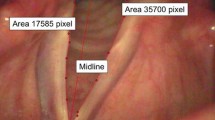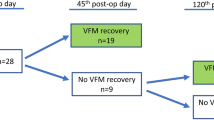Abstract
Objectives
To evaluate the prognostic value of the posterior cricoarytenoid (PCA) muscle atrophy observed on neck computed tomography (CT) in patients with unilateral vocal fold paralysis.
Methods
CT images of 87 subjects with unilateral vocal fold paralysis (UVFP) were evaluated to analyze the PCA muscle atrophy and to measure the severity of the PCA muscle atrophy in semi-quantitative manner. The grading of the PCA muscle atrophy was compared with the recruitment pattern of laryngeal electromyography (LEMG) and restoration of vocal fold movement.
Results
The PCA muscle was identifiable on CT in 73 subjects. Using the PCA muscle atrophy as an indicator of UVFP, we correctly predicted the paralysis in 69 (94.5%). Grade of the PCA muscle atrophy is significantly correlated with recruitment pattern of LEMG. If the positive result is defined as the PCA muscle showed moderate to severe degree of atrophy, we could predict the persistent UVFP in 88% of patients.
Conclusions
PCA muscle atrophy identified on CT scan in patients with UVFP, is associated with low rates of return of mobility in the affected vocal fold.




Similar content being viewed by others
References
Daniero JJ, Garrett CG, Francis DO (2014) Framework surgery for treatment of unilateral vocal fold paralysis. Curr Otorhinolaryngol Rep 2:119–130
Gupta SR, Bastian RW (1993) Use of laryngeal electromyography in prediction of recovery after vocal cord paralysis. Muscle Nerve 16:977–978
Blitzer A, Crumley RL, Dailey SH et al (2009) Recommendations of the neurolaryngology study group on laryngeal electromyography. Otolaryngol Head Neck Surg 140:782–793
Wang CC, Chang MH, Wang CP, Liu SA (2008) Prognostic indicators of unilateral vocal fold paralysis. Arch Otolaryngol Head Neck Surg 134:380–388
Hydman J, Bjorck G, Persson JK, Zedenius J, Mattsson P (2009) Diagnosis and prognosis of iatrogenic injury of the recurrent laryngeal nerve. Ann Otol Rhinol Laryngol 118:506–511
Grosheva M, Wittekindt C, Pototschnig C, Lindenthaler W, Guntinas-Lichius O (2008) Evaluation of peripheral vocal cord paralysis by electromyography. Laryngoscope 118:987–990
Elez F, Celik M (1998) The value of laryngeal electromyography in vocal cord paralysis. Muscle Nerve 21:552–553
Lin RJ, Munin MC, Rosen CA, Smith LJ (2017) Effect of intralaryngeal muscle synkinesis on perception of voice handicap in patients with unilateral vocal fold paralysis. Laryngoscope 127:1628–1632
Munin MC, Murry T, Rosen CA (2000) Laryngeal electromyography: diagnostic and prognostic applications. Otolaryngol Clin N Am 33:759–770
Munin MC, Rosen CA, Zullo T (2003) Utility of laryngeal electromyography in predicting recovery after vocal fold paralysis. Arch Phys Med Rehabil 84:1150–1153
Parnes SM, Satya-Murti S (1985) Predictive value of laryngeal electromyography in patients with vocal cord paralysis of neurogenic origin. The Laryngoscope 95:1323–1326
Sittel C, Stennert E, Thumfart WF, Dapunt U, Eckel HE (2001) Prognostic value of laryngeal electromyography in vocal fold paralysis. Arch Otolaryngol Head Neck Surg 127:155–160
Badia PI, Hillel AT, Shah MD, Johns MM, Klein AM (2013) Computed tomography has low yield in the evaluation of idiopathic unilateral true vocal fold paresis. Laryngoscope 123:204–207
Kwong Y, Boddu S, Shah J (2012) Radiology of vocal cord palsy. Clin Radiol 67:1108–1114
Agha FP (1983) Recurrent laryngeal nerve paralysis: a laryngographic and computed tomographic study. Radiology 148:149–155
Jacobs CJM, Harnsberger HR, Lufkin RB, Osborn AG, Smoker WRK, Parkin JL (1987) Vagal neuropathy—evaluation with CT and MR imaging. Radiology 164:97–102
Romo LV, Curtin HD (1999) Atrophy of the posterior cricoarytenoid muscle as an indicator of recurrent laryngeal nerve palsy. AJNR Am J Neuroradiol 20:467–471
Volk GF, Hagen R, Pototschnig C et al (2012) Laryngeal electromyography: a proposal for guidelines of the European Laryngological Society. Eur Arch Otorhinolaryngol 269:2227–2245
Seo HG, Jang HJ, Oh BM, Kim W, Han TR (2014) Use of ultrasonography to locate laryngeal structures for laryngeal electromyography. PM & R 6:522–527
Statham MM, Rosen CA, Nandedkar SD, Munin MC (2010) Quantitative laryngeal electromyography: turns and amplitude analysis. Laryngoscope 120:2036–2041
Statham MM, Rosen CA, Smith LJ, Munin MC (2010) Electromyographic laryngeal synkinesis alters prognosis in vocal fold paralysis. Laryngoscope 120:285–290
Sahgal V, Hast MH (1986) Effect of denervation on primate laryngeal muscles: a morphologic and morphometric study. J Laryngol Otol 100:553–560
Morledge DR, Lauvstad WA, Calcaterra TC. Delayed reinnervation of the paralyzed larynx. An experimental study in the dog. Arch Otolaryngol 1973;97:291–293.
Kano S, Horowitz JB, Sasaki CT (1991) Posterior cricoarytenoid muscle denervation. Arch Otolaryngol Head Neck Surg 117:1019–1020
Wu P, Chawla A, Spinner RJ, Yu C, Yaszemski MJ, Windebank AJ, Wang H (2014) Key changes in denervated muscles and their impact on regeneration and reinnervation. Neural Regen Res. 9:1796–1809
Wang H, Gu Y, Xu J, Shen L, Li J (2001) Comparative study of different surgical procedures using sensory nerves or neurons for delaying atrophy of denervated skeletal muscle. J Hand Surg Am. 26:326–331
Author information
Authors and Affiliations
Corresponding author
Ethics declarations
Conflict of interest
The authors declare that they have no conflict of interest.
Ethical approval
All procedures performed in studies involving human participants were in accordance with the ethical standards of the institutional research committee of Seoul National University Hospital (No. 1909-11-1066) and with the 1964 Helsinki declaration and its later amendments or comparable ethical standards.
Informed consent
The need for informed consent was waived by institutional research committee of Seoul National University Hospital.
Additional information
Publisher's Note
Springer Nature remains neutral with regard to jurisdictional claims in published maps and institutional affiliations.
Rights and permissions
About this article
Cite this article
Lee, D.Y., Kogay, D., Song, S. et al. Prognostic value of the posterior cricoarytenoid muscle atrophy in computerized tomography scans for unilateral vocal fold paralysis recovery. Eur Arch Otorhinolaryngol 277, 827–832 (2020). https://doi.org/10.1007/s00405-019-05780-3
Received:
Accepted:
Published:
Issue Date:
DOI: https://doi.org/10.1007/s00405-019-05780-3




